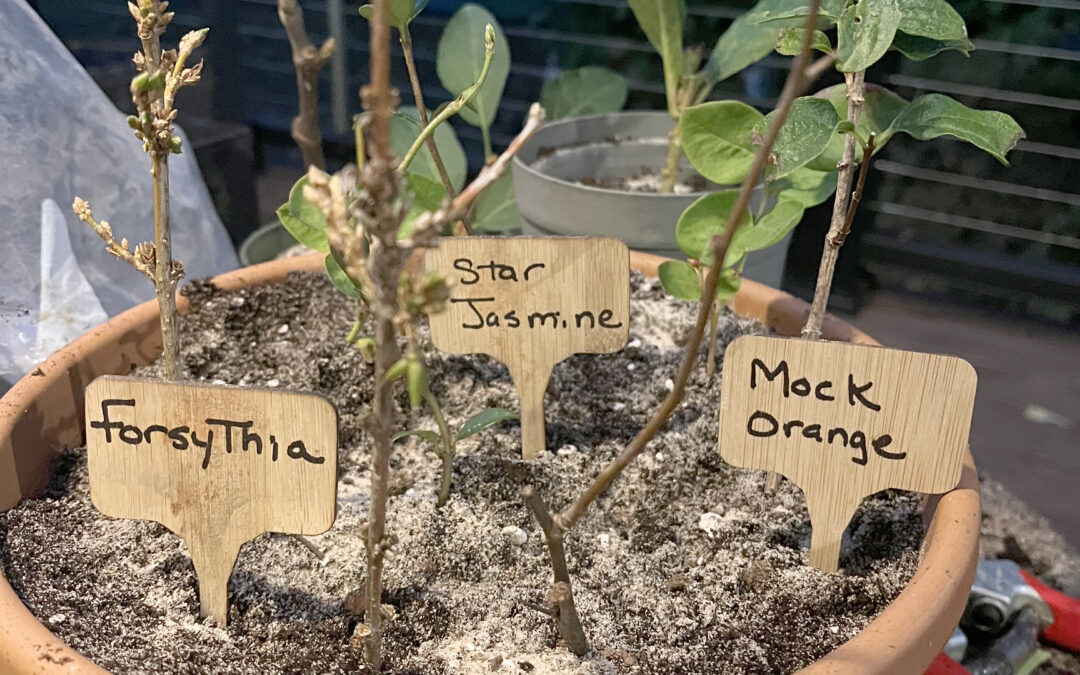Did you know that you can grow “twins” of your favorite plants this fall to create a thriving spring garden? In the past, we have talked about different ways to propagate or multiply your plants. Often, this occurs in spring when your plants are in full growing mode and you take advantage of their tender, new growth and energy. During that time, you would take the pliable new shoots called softwood cuttings to create additional plants. Spring would be the perfect time to grow cuttings from plants such as false indigo. However, in fall, we choose dormant plants to propagate by taking pencil-thick cuttings from the almost sleeping plant. These less pliable shoots are taken from the growth of the plant from the last season and are referred to as hardwood cuttings. This method works best for deciduous shrubs and trees (those that “decide” to lose their leaves in the fall). Using this method, you will be encouraging the “sticks” to form new roots during fall and winter, giving you free new plants for your spring garden.
When you propagate plants by taking cuttings, you are basically making a twin or clone of the original plant. Fall propagation of hardwood cuttings of dormant plants is less fussy and more hands-off than other methods of taking cuttings of plants. So while you are inside enjoying a steaming cup of hot chocolate, your plants will be quietly working to form roots underground. Great candidates for propagating your plants with this method are forsythia, mock orange, viburnum, weigela, willow, dogwood, fig, and blueberry plants. If you picture most of these plants, you realize we are looking at woody plants, which helps us understand how to choose hardwood cuttings.

Before you get started, gather your supplies and tools. You should make sure that your pruning shears are sterilized so that you don’t spread diseases between plants. It is a good idea to clean your pruners with rubbing alcohol between each cut. You will want to fill your pots or containers with a mixed growing medium that will retain some moisture but is also well-drained. You can use coarse builder’s sand, a combination of perlite and vermiculite, or potting soil and sand. While not necessary for growing cuttings, powdered rooting hormone will encourage root growth and increase your chances of success. Bottles of rooting hormone can be found in garden nurseries or online, and a little bottle will go a long way.
When you have all your supplies assembled, look for a nonflowering stem that is approximately six to eight inches long, and cut just below a leaf node. You should have a few more leaf nodes on the stem before you get to the top. If your cutting still has leaves, remove all but the top set. Dip the end of the stem in the rooting hormone and shake off the excess. Then make a two to four-inch hole with a pencil in your soil. Push your cutting into the hole and firm the soil around the stem. Water the soil well, making sure it drains so that your cutting doesn’t rot. You should take a few cuttings from each type of plant that you want to propagate to increase your odds for success. Be sure to label each cutting, because you will not remember what it is. Unlike softwood cuttings taken in spring, these hardwood cuttings will probably not have leaves to help you identify the plant.
Once you have planted your cuttings, you can place them outside in an area protected from harsh weather. Check your cuttings every once in a while; they should not need supplemental watering other than rain, but make sure they do not become either dried out from lack of rain or overly watered after a deluge. Some gardeners prefer to grow their hardwood cuttings indoors, but you need to make sure they receive sufficient (but not direct) sunlight and do not dry out. Keep in mind that propagating from dormant cuttings takes patience. It may take several weeks or months for your cuttings to develop roots. Fall propagation is for the long game. But your patience will pay off in spring when you have healthy new plants to fill your garden or share with friends.
I have tried to give detailed instructions that may sound overwhelming at first glance. However, multiplying your plants with hardwood cuttings can be as simple as plopping a cutting directly in your garden and forgetting about it. Once you have successfully grown a “twin” from an existing plant, you may become addicted to finding ways to grow new plants. Experiment with different methods, such as growing the same types of cuttings indoors and out. We would love to hear about your successes and what you learned when things did not turn out so well. Send your comments and questions to shorelocalgardener@gmail.com.
Tammy Thornton lives with her husband, children, and crazy pets while enjoying a life of gardening, cooking, and going to the beach.

















